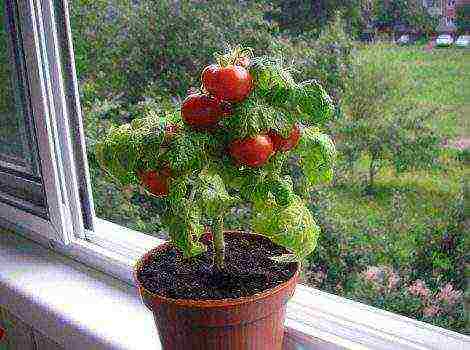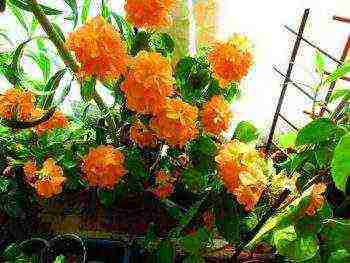Content [show]
To get a good pepper seedling and an excellent harvest, you need to provide the plants with several components: fertile soil, light, water and heat. And also - care. But in what proportions to give the seedlings what is necessary, we will now tell you.
Pepper belongs to heat-loving crops, therefore, in temperate and northern regions, it is grown mainly in seedlings. At home, seedlings are easiest to grow on a windowsill. There, the plant receives a sufficient amount of heat, light and moisture.
Preparing soil for seedlings
The soil for growing pepper seedlings must be loose, breathable, with a sufficient amount of nutrients, have a neutral reaction (pH) and at the same time remain moisture-absorbing. The soil and containers should be free of pests and pathogens.
Sift the ingredients for the substrate through a sieve to obtain a homogeneous mixture.
The simplest and most popular recipe for seedling soil can be prepared as follows: take 2 parts of garden soil, 1 part of humus or rotted manure, add a large handful of wood ash to 1 bucket of humus or manure. Then add 1 part peat and 1 part sawdust (or coarse sand).
Take garden land where nightshade crops have not been grown for the last 3-4 years: tomato, pepper, eggplant, potatoes.
Pepper is very sensitive to acidity and excess salts in the soil. The optimum pH is 6-6.5. If the acidity level exceeds this value, add 15-17 g of dolomite flour or lime per 1 kg of soil.
You can add a hydrogel to the soil. Soak small granules the size of a match head in water at a rate of 10 g per liter. When they are swollen, transfer them to the pepper pits. Consumption - about a small jar of swollen gel granules per hole.They absorb water and hold it until the earth dries up. Then the plant begins to slowly “drink” water from the granules and therefore does not dry out. The hydrogel helps the peppers wait until the next heavy watering. He successfully copes with the opposite situation - if you overdo it with watering, the granules will retain the excess moisture “in reserve”. The optimal frequency of watering seedlings on a hydrogel is 1 time in 10-20 days.
If you purchased soil from a store, you can improve it yourself. To do this, add 1.5 kg of sand to 5 liters of purchased soil, 1-2 tbsp. ash, 1-2 tbsp. dolomite flour and 1 tbsp. complex fertilizers.
Preparing seeds for sowing
Before sowing, the seeds must be pickled in a 2% solution of potassium permanganate at room temperature for 20-25 minutes. Then rinse them thoroughly in cold water and soak for 18-20 hours in a solution of Zircon (1 drop per 300 ml of water) or Epin (2 drops per 100 ml) at a temperature of 18-22 ° C. These preventive measures will help you avoid viral and fungal infections.
Pepper seedlings do not like transplants, so plant them immediately in a container in which they will grow.
Further, the seeds must germinate. To speed up this process, immerse them in nutrient solutions Ideal, Agricolastart, Albit, Gumi, according to the instructions for use. Then wrap the seeds in a damp cloth for 2-3 days and place in a plastic bag to create a greenhouse effect. The minimum temperature for pepper germination is 22-24 ° C.
The optimal time for sowing pepper for seedlings is the end of February - the beginning of March.
Seedlings in pots
The substrate is ready and needs to be poured into pots. But they also need to be selected and prepared. The pots are used for both single and group plantings. Considering that many large and capacious containers cannot be placed on the windowsill, they are usually taken for single plantings. Which pots are best for peppers?
- Plastic pots lightweight, fairly durable and can be of any shape. But if you accidentally damage such a container, the seeds will have to be transplanted.
- Clay pots - natural products that allow the roots to breathe and saturate them with moisture. The only drawback is that the roots can grow into the pot, which will cause difficulties when transplanting.
- Peat pots allow you to plant seedlings in open ground directly in them. At the same time, it is quite difficult to keep the pots transportable before planting in the ground, because water softens the peat.
- Paper cups and plastic bags - disposable containers that help to get high-quality seedlings. The disadvantage of plastic bags is that the root system of the pepper hardly breathes in them.
Fill seedling containers about three quarters
For starters, you can use small pots with a diameter of 4-5 cm. So they take up little space, it is convenient to rearrange them if necessary, and they warm up faster. When the plants grow up and begin to shade each other, transplant the peppers in containers with a diameter of 10-12 cm, especially if you are growing mid-ripening and late-ripening varieties with large leaves.
Having chosen a pot, you can start sowing. Sprouted seeds or seedlings 5-8 mm long are planted in pots with soil and covered with foil or glass. If the soil temperature approaches 25-27 ° C, then the first shoots will appear in 3-5 days.
Seedlings in boxes
You can grow a lot of good seedlings without pots. In this case, you will need a seedling box or a plastic container 12-15 cm deep.
If you want to get a lot of seedlings, take a box of 30x50 or 40x60 cm in size, for each box you need 1-2 bags of seeds.
For seedlings, it is better to use plastic boxes.
The order of sowing seeds is as follows:
- make grooves in the ground with a depth of 1-2 cm, at a distance of 2-3 cm from each other;
- plant the seeds so that there is 2-3 cm between the plants;
- cover the box with foil or glass and put it in a warm place, preferably in the sun;
- moisten the soil every 1-2 days with a hand sprayer;
- as soon as shoots appear, transfer the box for 5-7 days to a bright place with a constant temperature of 16-18 ° C.
Care before germination
In the first 2-3 days from the emergence of seedlings, arrange the seedlings "anhydrous diet" - do not water the plant, but only slightly moisten the surface with a spray bottle. When the cotyledons appear, water the seedlings with warm water (30 ° C). During this period, it is important to maintain a balance, since excessive moisture can lead to the development of putrefactive diseases, and a lack of moisture can cause wilting. Do not forget about the ventilation of the plants, but beware of cold drafts from the window - they can destroy the seedlings.
Loosen the soil periodically to a depth of 5-7 cm
Seedlings can weaken from lack of light and heat. In this case, it is useful to treat it with Epin's solution 2-3 times with an interval of 8-10 days. Along the way, carry out additional lighting of the seedlings with fluorescent lamps. In this case, ordinary lamps are almost useless - they dry and heat the air more. They also negatively affect the growth of seedlings and heating batteries; to compensate for their influence, shields of foil, cardboard and plywood must be installed.
After 2-3 weeks, feed the roots with Potassium Humate (25 ml per 10 L of water). The consumption of the composition for one plant should not exceed 300 ml.
Until the formation of 5-6 true leaves, the seedlings grow slowly (during this period, flower buds are laid). But before budding, when there are already 6-8 true leaves on the bush, and also during the flowering period, there is a sharp growth of “home seedlings”. At this time, carry out the last feeding. In 10 liters of water, dilute 1.7 g of boric acid, 1 g of ferrous sulfate, 0.2 g of copper sulfate, the same amount of zinc sulfate and 1 g of manganese sulfate. Apply no more than 500 ml per plant.
Everything is not so complicated as it seems at first glance. Follow this algorithm, and you will very soon become the owner of first-class seedlings. All that remains is to plant the pepper in open ground or a greenhouse and wait for a rich harvest.
However, if you want to grow bell peppers, then there is nothing difficult, you just need to follow the recommendations.
Growing peppers from seeds at home with a step by step photo
This is southern culture loves warmth and bright sunso it is important to provide it with an appropriate location. However, seedlings should be protected from exposure to too bright sun, so as not to burn the weak leaves.
Choosing seeds
When you enter a gardening store, you are faced with a difficult choice: which variety is better.
Important! Not all peppers are suitable for balcony cultivation.
Pay attention to the size of the adult plant. You should also take into account the timing of emergence and the rate of fruiting. At home, we want to get the fruits as quickly as possible.
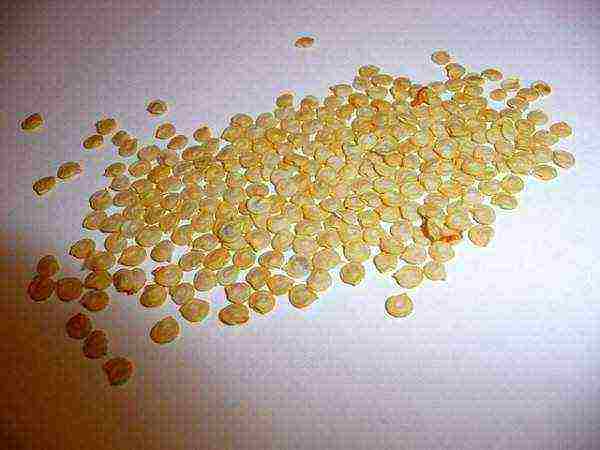
We plant
How to grow peppers from seeds at home? After you have chosen the right variety, you should plant the seeds. Many experienced gardeners recommend pre-soak them in a damp cloth or cheesecloth for four days. There are also recommendations to soak them for several hours in a weak solution of potassium permanganate in order to avoid the appearance of diseases.
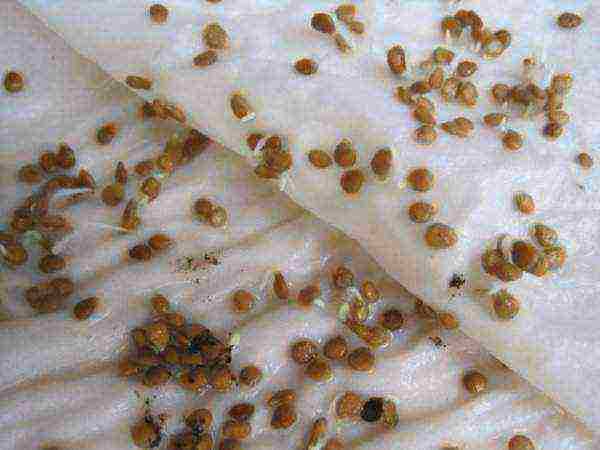
After the seeds have hatched, they must be carefully planted in small containers. For these purposes seedling pots work wellsuch as peat or small plastic cups.
You can plant seeds directly into the ground, they will germinate a little longer. For these purposes also small peat tablets are conveniently suitable for seedlings.
REFERENCE! Learn about planting methods such as toilet paper and snail.
Different varieties germinate in different ways, some up to 3 weeks, so you have to be patient.
Attention! Check soil moisture daily. The soil should not dry out, but also not be too wet. You can use a spray bottle to moisten the soil.
You should adhere to the temperature regime... The optimum temperature for germination of pepper seeds is 18-25ºC.
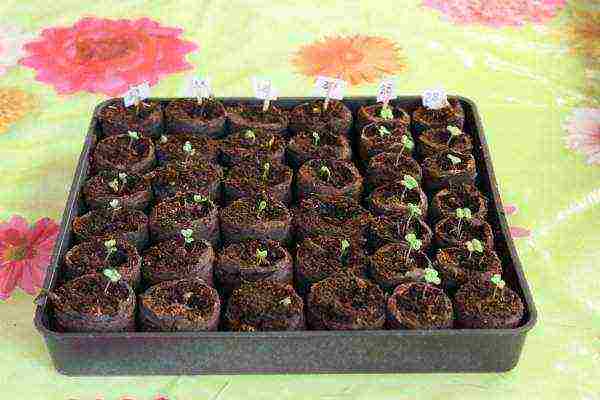
The first shoots have sprung up, what to do next?
After a while, seedlings appear. Now they need create the most optimal conditions... The first is light. If it is not enough, then the plants will begin to stretch, and then completely die.
Attention! Do not place young seedlings directly under the scorching sun.
It is convenient to use artificial lighting for seedlings. Special lamps for flowers are now on sale, but you can also use daylight, choosing the right amount. Incandescent lamps are not suitable for these purposes - they emit little light, but a lot of heat, which can burn delicate leaves.
Daylight lamps are positioned at about a height of 30 cm, daylight hours should last about 18 hours, but not less than 14 hours. In order to make it more convenient, you can connect special on / off control timers to the luminaire.
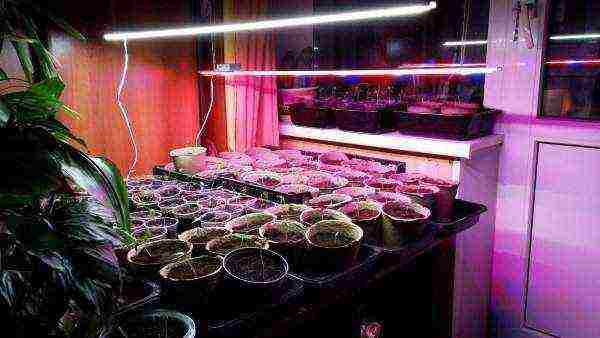
We land on a permanent place
As soon as the pepper seedlings reach 10-15 cm, it must be dropped off at a permanent place... Use large pots or boxes for these purposes: it grows quickly and has an extensive root system.
We carefully take out the sprout. The most convenient and less traumatic for the plant use the transshipment method... Pepper, sprouted in peat tablets, is planted with them in a pot.
Keep in mind that the larger the planting container, the larger the plant will be. As soon as the frost passes, the plant is taken out to the balcony.
If you grow large varieties of bell peppers, then take care of large containers and methods of garter plants.
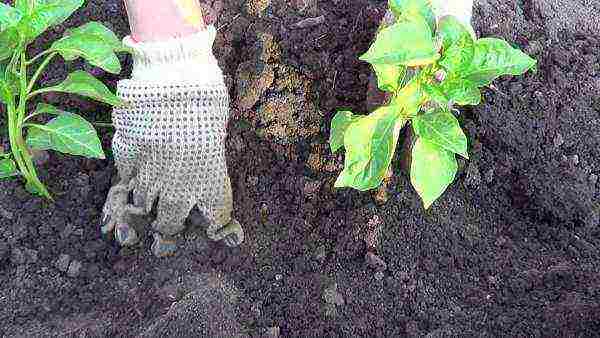
Soil for pepper and top dressing
Excellent suitable soil for seedlings, as well as garden soil... Peppers need a lot of nutrients for good fruiting, so humus is added.
Fertilizers are used only specially designed for vegetable crops.
Remember! You eat the fruits, so it is not recommended to over-water with top dressing.
The safest feeding is humus. You can also mix wood ash with water at the rate of 2 tablespoons per liter.
Watering
The plant needs a regular supply of moisture. Water is used warm, better settled, without chlorine... Do not allow the soil to dry out, otherwise the buds and fruits may begin to fall off.
Growing pepper seedlings on the windowsill
As we remember, pepper is a southern culture. Place it in the lightest and warmest place. Avoid drafts. It is great if the balcony is glazed, so you can avoid the effects of spring frosts.
Growing peppers on a windowsill has its own characteristics: choose the lightest window or provide additional lighting.
Additional care
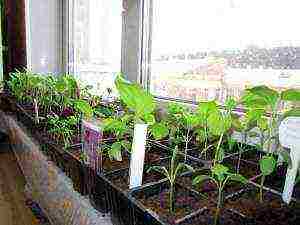 Inspect the plant for pests daily. Even at home in plants sometimes diseases appear and pests attack.
Inspect the plant for pests daily. Even at home in plants sometimes diseases appear and pests attack.
If you notice dark spots, yellow, curled and falling leaves, as well as insects, take action immediately, otherwise the plant can be lost. What to do if seedlings fall?
Interesting
Many varieties of chili peppers can grow and bear fruit in a room for several years. There is an interesting variety, the fruits of which change color depending on the stage of development. Hot peppers come in varying degrees of pungency. The sizes of the fruits also differ. A small-fruited variety is suitable for the kitchen, it will also be a decoration of the room and an excellent seasoning for dishes.
In general, caring for sweet and hot peppers is not difficult. The most important thing is to germinate the seedlings correctly, choose a large container and ensure the maximum supply of light.
So, today we looked at how to grow pepper seedlings on the windowsill, what nuances do you need to take into account? But growing peppers on the balcony is much easier, so we recommend this method for novice gardeners.
Useful video
Pepper is an irreplaceable vegetable crop.This vegetable contains many vitamins, it is consumed fresh, seasonings, salads and preserves are made from it. This crop is in demand, so many are trying to grow it on their own.
However, pepper is very whimsical. To get good strong seedlings and a high-quality harvest, you must follow some growing rules. This article will tell you how to choose the right variety, prepare seeds, choose a container, how to plant and how to grow pepper seedlings from seeds at home.
Preparation of planting material
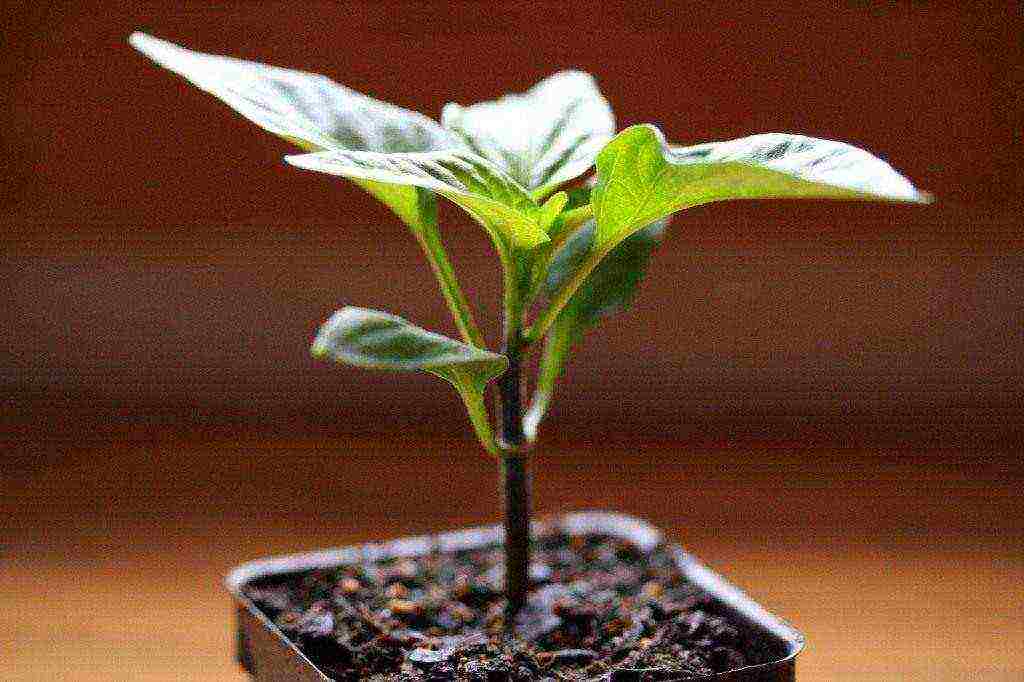
Variety selection
First you need to decide on the choice of pepper variety. You can pick it up individually for each consumer, because there are sweet, and spicy, and pungent varieties. At the same time, the cultivation of, for example, the same sweet bell pepper is no different from its other varieties. They are equally demanding on lighting, moisture and temperature.
There is a huge selection of peppers on the market today.
It's not hard to get lost in such a variety, so here's a quick reference:
- high-yield varieties: Big Papa, Bogatyr, Bugai;
- varieties for greenhouses: Ilya Muromets, Orange Miracle, Gambler;
- early varieties: "Tenderness", "Buratino", "Winnie the Pooh";
- late varieties: "Swallow", "Nochka", "Alyonushka";
- spicy varieties: "Adjika", "Astrakhansky".
Seed treatment
The first step is to visually inspect the seeds. Small, damaged and deformed ones must be removed. Then the seeds remaining as a result of selection are disinfected. They are placed in gauze bags, and then dipped in a dark pink concentrated solution of potassium permanganate for 20-30 minutes.
Also, you can dip them in a solution of any fungicide ("Fitosporin", "Vitaros"), following the instructions for use. After that, the seeds are thoroughly washed with running water.
To obtain strong and healthy seedlings, pepper seeds can be soaked in a complex nutrient solution. For example, you can add nitrophoska or wood ash to the water at the rate of 1 tsp. substances per 1 liter.
In such a mixture, gauze bags with seeds must be kept for 24 hours. You can also use the drug "Azotfit" (5-10 ml per 0.5 l of water). In this solution, pepper seeds are kept for 2 hours.
Another option is to dip the seeds in gauze for 24 hours in a liquid solution of the Ideal fertilizer. The solution temperature should be 25-28 degrees Celsius. Well, the last, but no less effective solution is to soak the seeds in Epin (this is a growth stimulant) for 12 hours. One or two drops of the drug are enough for every 100 ml of water.
Germination and hardening
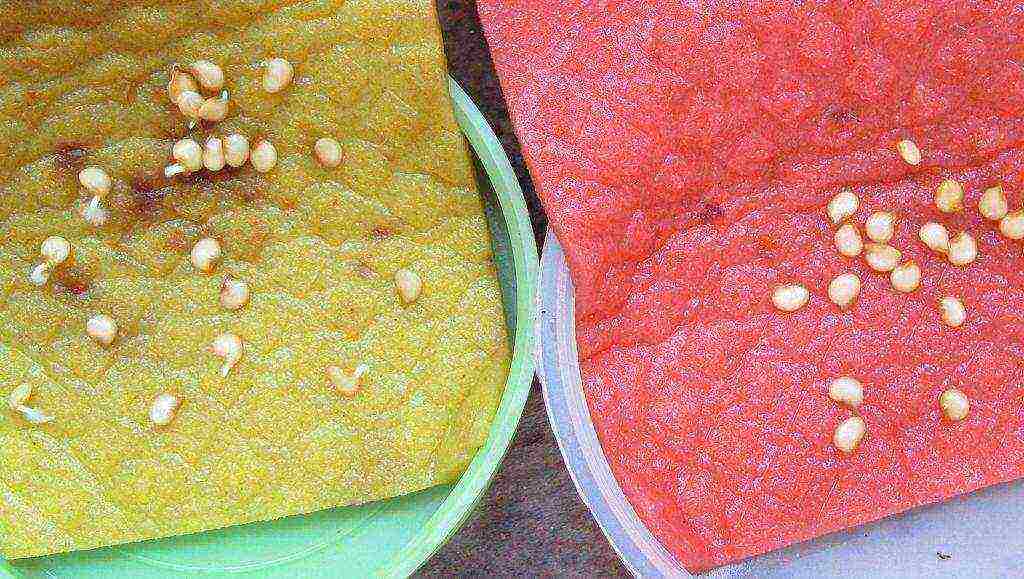
After the above procedures, the seeds of the peppers are germinated. This is best done on a raised surface (such as a saucer, plate, or jar lid). A moistened gauze, cotton wool or cotton cloth is placed on the bottom of the container.
Pepper seeds are evenly placed on top (they must be of the same grade) and covered with the same moist material. After that, the container is covered with a film and placed in a warm place (the air temperature must be at least 25 degrees Celsius). Periodically, water is poured into the fabric so that the seeds do not dry out. After 1-2 weeks, they will sprout. After that, they can be planted in seedling containers.
But before planting, bell peppers can be hardened using a simple, simple trick. The seeds of the peppers must be kept alternately in the cold, then in the warmth.
First, the planting material is placed in the refrigerator for 2 days (on the bottom shelf). Then they are kept indoors at room temperature (17-18 degrees) for a day. Then they are again transferred to the refrigerator, and after two days, the seeds are taken out and immediately sown.
Choice of capacity
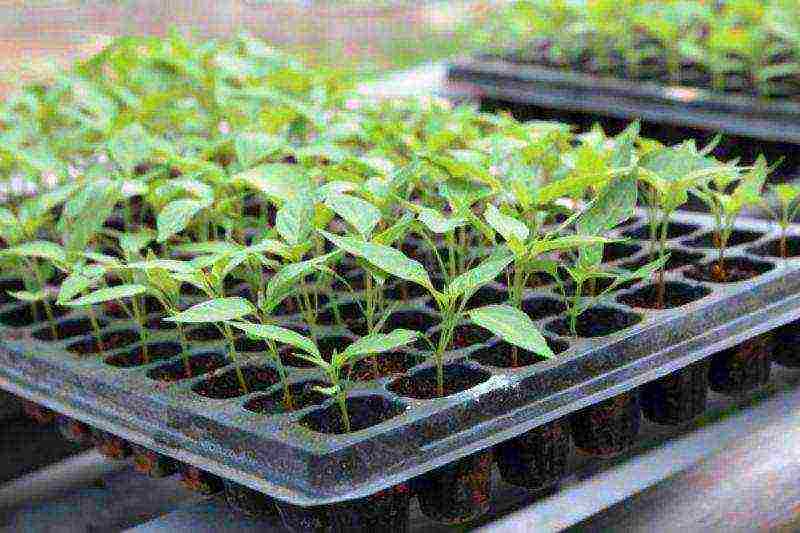
Sweet pepper has a very delicate root system; the culture takes a long time to recover from damage. Therefore, picks must be avoided by initially planting seeds in separate large containers (10x10 cm) or seedling boxes (at least 6 cm deep).
Pots or large glasses with a depth of 10-12 cm and a diameter of 7-10 cm are perfect. The container should be spacious (so that a large lump of earth can be transferred with the seedlings later) and deep (low containers negatively affect the growth of bell pepper).
Experienced gardeners do not recommend planting sweet pepper seeds in pressed cardboard pots, as the glue used in them can be toxic to seedlings.
Soil preparation
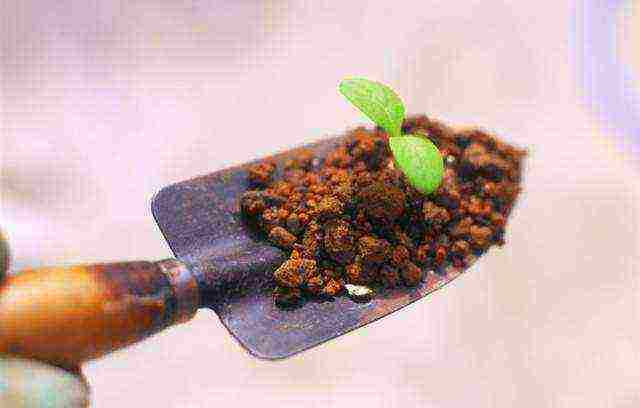
The successful cultivation of peppers from seed largely depends on the correct selection and preparation of the soil. Clayy and heavy soil with high acidity will not work. It is better to prepare the substrate yourself.
There are a number of requirements for the soil:
- fertility;
- looseness;
- moisture capacity;
- nutritional value;
- neutral or slightly acidic reaction (6-6.5 pH).
The soil should also be free of pathogenic bacteria and pests.
There are several options for preparing the substrate:
- Mix sandy loam meadow soil with peat and humus in a ratio of 2: 2: 1. For 10 kg of substrate, 2 matchboxes of superphosphate and 1 boxes of potassium sulfate are added to the mixture.
- Mix the top layer of soil, high-moor peat and sand in a 1: 2: 1 ratio. The acidity of the mixture can be extinguished by adding lime fertilizers to it.
- Mix humus, turf soil and river sand in a ratio of 3: 3: 1. A glass of wood ash is added to 10 kg of the mixture.
In addition, ready-made substrates (for example, "Biogrunt" and "Zhivaya Zemlya") are sold in specialized gardening stores. This is an excellent solution for summer residents who do not have access to the above components, and for beginners who are not yet confident in their abilities.
Sowing seeds
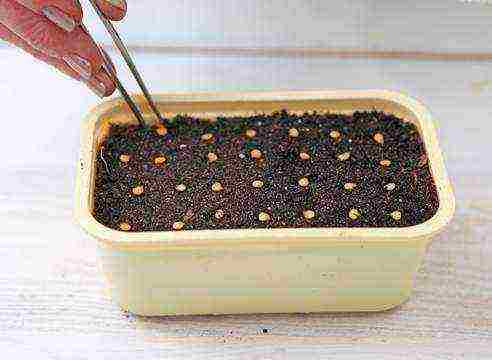
Sowing dates
When to sow sweet pepper seeds? It all depends directly on the variety. More specifically, from its ripening time. Early and mid-early varieties of peppers should be sown during March. In this case, the seedlings are transplanted into open ground after 50-60 days.
Mid-late and late varieties are sown from mid-February to mid-March. For planting seedlings in open ground, its age should be 60-75 days.
Planting is usually done at the end of April. First, the seedlings can be planted in a heated greenhouse (around the end of April), in the second half of May they are moved to a greenhouse, and in the first half of June, the pepper is already planted in open ground.
Sowing process
Finally, we proceed to sowing seeds. To begin with, the containers for planting are washed. Then they are filled with earth, it is lightly tamped. The rim of the container should rise about 2 cm above the soil surface.
In the seedling box, parallel grooves are made with a depth of 1-1.5 cm, keeping a distance of 3-4 cm between them. Pepper seeds are planted at a distance of 1-1.5 cm from each other. In separate containers, two holes are made. One seed must be planted in each hole.
After that, they are covered with a substrate from above. At the end, each container is covered with a thin cling film and placed in a warm place (for example, near a battery).
Necessary conditions for seed germination

For fast germination of seeds, it is necessary to create a greenhouse effect. As already mentioned, the container with the planting must be covered with foil or glass and placed in a warm place. The air temperature should be 25-28 degrees Celsius. It must be maintained until the first shoots appear. If the appropriate regimen is observed, this happens 5-7 days after sowing the seeds.
Throughout this period, the soil should be moderately moist. Water must not collect in the sump. Watering is carried out with warm water through a sieve or watering can, so as not to expose the seeds and knock them out of the soil.
Another important aspect is lighting. Bell pepper is a light-loving and heat-loving culture. There is enough sunlight on the windowsill for her, but at the same time it is cool there. Therefore, it is better to use a phytolamp (it will come in handy after germination).
Growing seedlings
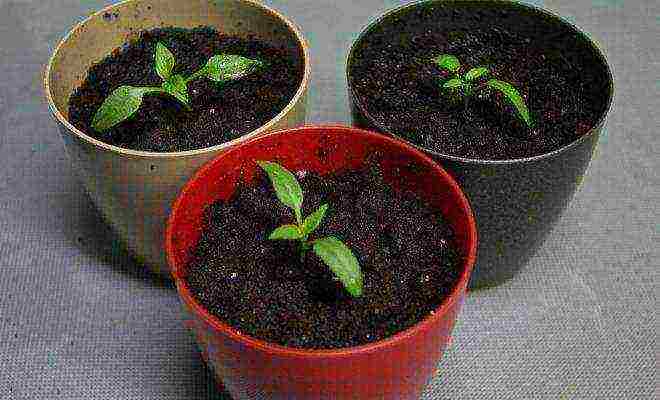
Temperature regime
So how to grow pepper seedlings from seeds at home? After the appearance of the first shoots, the containers with seeds are moved to a light window sill and the film is removed from them. Daytime temperatures should be 13-16 degrees, and nighttime temperatures should be 8-10 degrees.
Such conditions should be observed during the week. During this period, the root system of the seedlings is formed, and this temperature regime contributes to its strengthening. A week later, the temperature is again raised to 25-27 degrees during the day and 17 degrees at night.
A month before planting in a permanent place, the seedlings begin to be taken out into fresh air in order to gradually harden it and allow it to get used to the environmental conditions.
Watering
Watering is also important. In the first few days after the emergence of seedlings, it is not necessary to moisten the soil. Sweet pepper seedlings are watered every 7 days. Water is poured under the root, trying not to fall on the sprouts. The temperature of the liquid should be 28-30 degrees.
You cannot water the seedlings of peppers with cold water. Periodically, the topsoil must be carefully loosened.
Lighting
Bell peppers are very fond of light. At home, it is advisable to place a container with seedlings on the lightest windowsill (preferably on the south side).
During the first two to three weeks, it is advisable to use additional lighting (the same phytolamp). The containers need to be unwrapped periodically so that the lighting is uniform throughout the growing period.
Picking
If the seeds were planted in seedling boxes or small pots, then after the development of two to four true leaves (about a month after germination), the seedlings of peppers should be dived into separate containers with a volume of at least 0.5 liters.
Top dressing
When the first shoots appear, top dressing is applied. It can be liquid yeast or ash fertilizers. Any complex preparation for seedlings (for example, "Kemira Combi") is also suitable.
After that, fertilizing is applied twice more:
- 2 weeks after the pick (5 g of urea and 30 g of superphosphate are dissolved in a bucket of water);
- a few days before planting seedlings (50 g of superphosphate and 25 g of potassium sulfate per bucket of water).
The flow rate is the same as for regular watering. You can also use ready-made fertilizers from the store ("Solution", "Agricola").
Planting seedlings in the ground

We figured out how to grow pepper seedlings from seeds at home. Now it is important that the fruits of our labors are not wasted. Sweet pepper seedlings still need to be properly planted. Planting is carried out after the appearance of the first buds. In this case, the plant should have at least six to eight leaves.
The soil should be well warmed up by the sun, so planting should be planned for late May or early June. Seedlings are carefully taken out of containers, before planting, they need to be watered (so that a soil lump remains on the roots).
If the plant grew in peat pots, then it is not removed from there, but planted along with the container. For hot peppers, the distance between the rows should be about half a meter, for sweet peppers - 70 cm.In one row, plants are placed every 40-50 cm.
Seedlings are planted in the evening, the air temperature should be at least 17 degrees. Bulgarian pepper is deepened into the soil until the first leaves. The hole is buried, the earth is slightly loosened. Young leaves of peppers are very fragile and tender, so it is recommended to tie them up after planting.
If the temperatures are low at night and there is a possibility of frost, then it is advisable to cover the seedlings with a thin film until stable warm weather is established.
Despite the laborious process of growing pepper seedlings from seeds, this crop remains one of the most popular and in demand. The main thing is desire and a responsible approach. And then growing this healthy vegetable will be an easy task for any gardener.
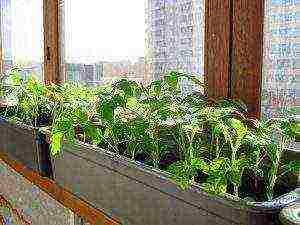
Growing peppers at home is becoming an increasingly popular activity for those who do not have a summer cottage.Now there are many interesting varieties that are suitable for planting on balconies and window sills. If there is not much space in the house, then it is better to choose mini-varieties.
Conditionally, pepper for the home can be divided into sweet varieties and hot ones, there is also a decorative pepper. The latter are more suitable, since they are of short stature and abundant fruiting.
…
However, if you want to grow bell peppers, then there is nothing difficult, you just need to follow the recommendations.
Growing peppers from seeds at home with a step by step photo
This is southern culture loves warmth and bright sunso it is important to provide it with an appropriate location. However, seedlings should be protected from exposure to too bright sun, so as not to burn weak leaves.
Choosing seeds
When you enter a gardening store, you are faced with a difficult choice: which variety is better.
Important! Not all peppers are suitable for balcony cultivation.
Pay attention to the size of the adult plant. You should also take into account the timing of germination and the rate of fruiting. At home, we want to get the fruits as quickly as possible.
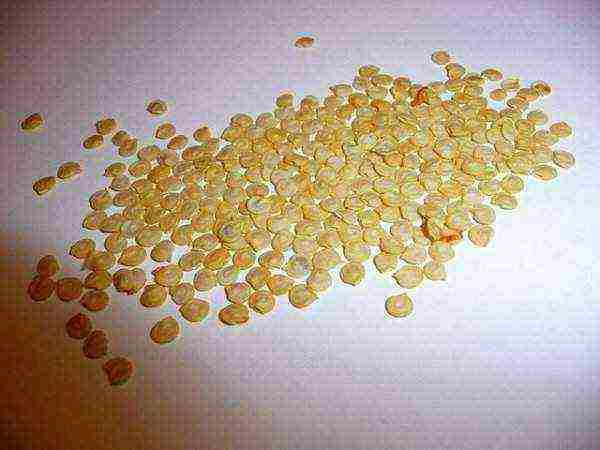
We plant
How to grow peppers from seeds at home? After you have chosen the right variety, you should plant the seeds. Many experienced gardeners recommend pre-soak them in a damp cloth or cheesecloth for four days. There are also recommendations to soak them for several hours in a weak solution of potassium permanganate to avoid the appearance of diseases.
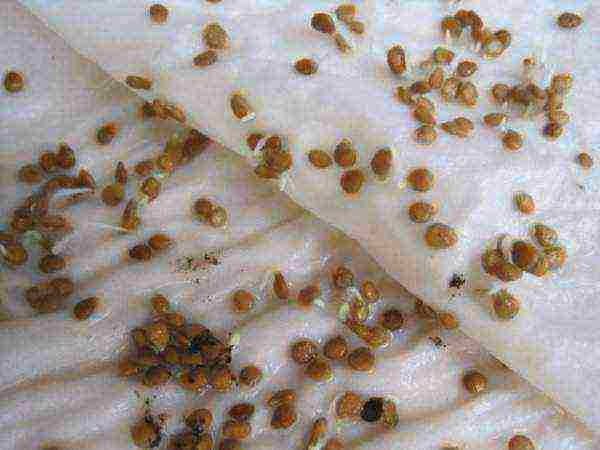
After the seeds have hatched, they must be carefully planted in small containers. For these purposes seedling pots work wellsuch as peat or small plastic cups.
You can plant seeds directly into the ground, they will germinate a little longer. For these purposes also small peat tablets are conveniently suitable for seedlings.
REFERENCE! Learn about planting methods such as toilet paper and snail.
Different varieties germinate in different ways, some up to 3 weeks, so you have to be patient.
Attention! Check soil moisture daily. The soil should not dry out, but also not be too wet. You can use a spray bottle to moisten the soil.
You should adhere to the temperature regime... The optimum temperature for germination of pepper seeds is 18-25ºC.
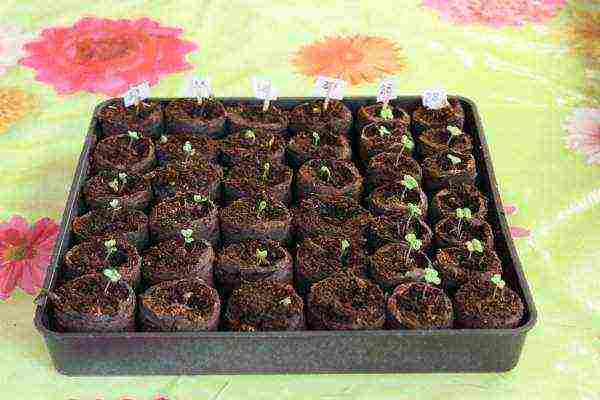
The first shoots have sprung up, what to do next?
After a while, seedlings appear. Now they need create the most optimal conditions... The first is light. If it is not enough, then the plants will begin to stretch, and then completely die.
Attention! Do not place young seedlings directly under the scorching sun.
It is convenient to use artificial lighting for seedlings. Special lamps for flowers are now on sale, but you can also use daylight, choosing the right amount. Incandescent lamps are not suitable for these purposes - they emit little light, but a lot of heat, which can burn delicate leaves.
Daylight lamps are positioned at a height of about 30 cm, daylight hours should last about 18 hours, but not less than 14 hours. In order to make it more convenient, you can connect special on / off control timers to the luminaire.
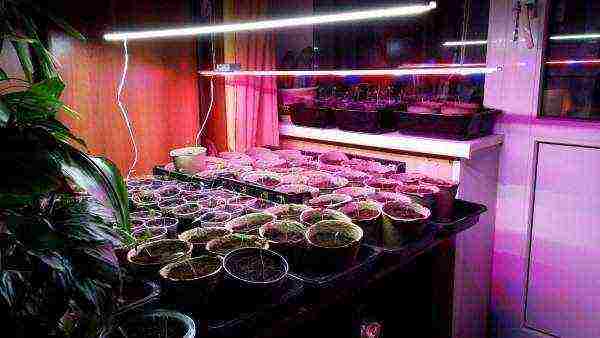
We land on a permanent place
As soon as the pepper seedlings reach 10-15 cm, it must be dropped off at a permanent place... Use large pots or boxes for these purposes: it grows quickly and has an extensive root system.
We carefully take out the sprout. The most convenient and less traumatic for the plant use the transshipment method... Pepper, sprouted in peat tablets, is planted with them in a pot.
Keep in mind that the larger the planting container, the larger the plant will be. As soon as the frost passes, the plant is taken out to the balcony.
If you grow large varieties of bell peppers, then take care of large containers and methods of garter plants.
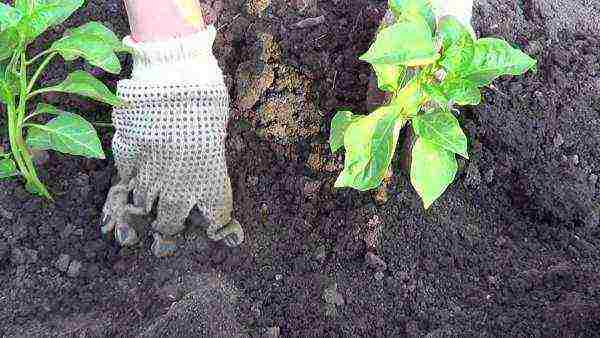
Soil for pepper and top dressing
Excellent suitable soil for seedlings, as well as garden soil... Peppers need a lot of nutrients for good fruiting, so humus is added.
Fertilizers are used only specially designed for vegetable crops.
Remember! You eat the fruits, so it is not recommended to over-water with top dressing.
The safest feeding is humus. You can also mix wood ash with water at the rate of 2 tablespoons per liter.
Watering
The plant needs a regular supply of moisture. Water is used warm, better settled, without chlorine... Do not allow the soil to dry out, otherwise the buds and fruits may begin to fall off.
Growing pepper seedlings on the windowsill
As we remember, pepper is a southern culture. Place it in the lightest and warmest place. Avoid drafts. It is great if the balcony is glazed, so you can avoid the effects of spring frosts.
Growing peppers on a windowsill has its own characteristics: choose the lightest window or provide additional lighting.
Additional care
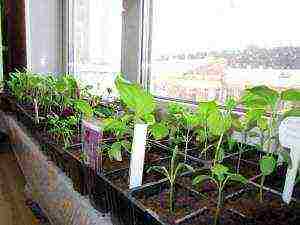 Inspect the plant for pests daily. Even at home in plants sometimes diseases appear and pests attack.
Inspect the plant for pests daily. Even at home in plants sometimes diseases appear and pests attack.
If you notice dark spots, yellow, twisted and falling leaves, as well as insects, take action immediately, otherwise the plant can be lost. What to do if seedlings fall?
Interesting
Many varieties of chili peppers can grow and bear fruit in a room for several years. There is an interesting variety, the fruits of which change color depending on the stage of development. Hot peppers come in varying degrees of pungency. The sizes of the fruits also differ. A small-fruited variety is suitable for the kitchen; it will also be a decoration of the room and an excellent seasoning for dishes.
In general, caring for sweet and hot peppers is not difficult. The most important thing is to germinate the seedlings correctly, choose a large container and ensure the maximum supply of light.
So, today we looked at how to grow pepper seedlings on the windowsill, what nuances should be taken into account? But growing peppers on the balcony is much easier, so we recommend this method for novice gardeners.
Useful video
Pepper is one of the most popular vegetable crops. To achieve maximum results, you need to calculate everything correctly when growing it. Many people know how to collect pepper seeds, but we will tell you how to grow pepper from seeds in order to reap a rich harvest.
Planting in open ground with seeds
The first way you can go is to grow pepper seeds outdoors. This option is considered more risky, because if you sow pepper seeds directly into the ground, they may not take root and germinate, since everything here will depend on weather conditions. However, if you live in the southern region and don't want to mess with your seedlings, you can try growing indoor peppers outdoors.
Variety selection
The very first thing you have to do is choose the variety of pepper you will plant in your garden. You should not choose early varieties for sowing; it is best to plant peppers of medium or late ripening. Of the recommended varieties, the following can be distinguished: Adjika, Astrakhansky, Miracle of the Moscow Region and Double abundance.
Necessary conditions for growing
The main condition for planting this vegetable crop with seeds in open ground is a warm climate. This vegetable is very whimsical and is afraid of frost, so if you live in a cold region, it is better to leave this venture. If you have already decided to plant seeds in open ground, wait until it warms up, when there will be no sharp drops in temperature.
Sowing dates
As already mentioned, pepper tolerates low temperatures very negatively, so you need to plant it in the summer. If this is of great importance to you, you can of course check the lunar calendar to find out exactly which number is the most favorable for landing.However, most often planting of seeds is carried out in the first half of June (approximately 6-7 number). By this time, there should be no cold snaps, so peppers can grow right in the ground without any problems.
Site selection and soil preparation
Best of all, this vegetable crop will grow in light and fertile soil, so try to avoid "heavy" soils, where the planting material will definitely not take root. To properly prepare the ground, you need to take care of organic fertilizers that will warm up the soil (as already mentioned, this plant loves heat very much). To do this, carefully dig up the soil before planting and add organic matter there. Manure and peat diluted with water are suitable. After that, it is necessary to loosen the ground again.
Sowing rules
Wait for a cool day, and you can start sowing (it is best to do this in the evening). To sow the seeds correctly, it is necessary to place about 5-6 seeds in the prepared holes filled with soil and humus. You should not put one seed in one hole - so the chances of success are almost zero. After the seeds are in the hole, it is necessary to cover them with earth and pour them over with settled water. The planting material does not need to be buried deeply - it is enough for the seeds to be placed in the ground to a depth of about 3 cm.The distance between the holes should be about 30 cm.
Watering and feeding
How to grow pepper seeds outdoors? As already mentioned, after planting, future bushes are watered with water and covered with foil until the first shoots appear. Usually the film is removed after 5-10 days, and at the same time the first dressing is applied. As a top dressing, an ash or yeast liquid fertilizer is perfect.
Shaping and other care
All further actions consist in the fact that as the bush itself forms, you will need to perform a procedure called thinning twice. The first time this must be done when 2-3 leaves appear (2-3 plants are left in the hole). The second procedure is carried out after the appearance of 5-6 leaves, and it is at this stage that you need to leave the strongest bush. Also, if frost or hail is planned, it is recommended to cover the seedlings with agrofibre so that they remain intact.
Planting seedlings
Growing seedlings of peppers is a much less dangerous method than the previous one. You can easily grow pepper seeds at home, since the success of this enterprise will not depend on weather conditions. Therefore, now we will talk in detail about how to grow homemade pepper from seeds.
Variety selection
The choice depends on the conditions in which you are going to grow this vegetable. If you have a greenhouse, then absolutely any variety can be grown in it, since the conditions are most suitable there. If you grow seedlings on the balcony, the following varieties are perfect: Ilya Muromets, Karapuz, Gambler and Orange Miracle. But in general, it all depends on your personal preference.
Necessary conditions for growing
To grow pepper seedlings at home, certain conditions must be provided. These include:
- Air temperature and soil temperature. The room temperature must be at least +25 ° C, and the minimum ground temperature must be +18 ° C.
- Good lighting.
- Regular watering and loosening of the soil.
- Optimum air humidity (if this point is violated, there is a high probability of falling flowers).
- Protection from pests and regular inspection of bushes for insects.
Sowing dates
When calculating the sowing time, it must be borne in mind that seedlings are usually planted in 60–80 days. Of course, given the characteristics of the selected variety, the timing may slightly shift. It is also worth considering that by the time the seedlings are planted in the ground, it should be warm enough. Based on this, you can deduce the exact dates of planting.
Capacity and soil
Almost any container is perfect for the procedure, be it a peat pot or a plastic cup. Before adding soil to the container, it must be disinfected. This can be easily done by washing the pots in a solution of potassium permanganate or with laundry soap. Peat pots or paper cups are ideal, because this way, when planting in the ground, you will not be able to remove the seedlings from the container (the material from which the cups are made decomposes).
The soil should be light and loose. You can purchase a ready-made substrate or prepare it yourself. To do this, mix the earth with sand and turf (2: 1: 1), and add a tablespoon of wood ash with superphosphate (per 10 liters of soil). Also note that it is better not to use garden soil, but to disinfect the mixture that you have prepared (using potassium permanganate) before planting.
Sowing rules
The soil in the pots is compacted so that the edge of the container is no more than 2 cm. Then pepper seeds are planted about a centimeter deep, and the pots themselves are placed at a distance of 3 cm from each other. Cover with foil or glass and leave in a warm place. It is also recommended that you prepare the tags with the names of the varieties in advance so as not to get confused.
Further care
How to grow pepper seedlings? In the first week, the formation of roots takes place, at this time the temperature should be + 14… + 16 ° C. In the second week, the temperature is raised to +25 ° C during the day and to +17 ° C at night.
Water the seedlings once a week. In addition, it is necessary to apply fertilizers - an excellent option would be a solution with calcium soda (a spoonful of calcium soda in a bucket of water). Also take care of lighting, as this is an important factor in the growth of the seedlings. When your seedlings have two leaves, you can make a pick for the growth of lateral and adventitious roots.
Also remember to temper the plant by bringing them out into the fresh air as they grow up (try to avoid drafts, though!).
Landing in the ground
Planting can be done after the first buds have appeared, and there are at least 8 leaves. By that time, the stem reaches about 2.5 cm in length. The main condition is warmed-up soil (therefore, pepper is planted in open ground from late May to early June). The plant is taken out of the pots (or not if peat pots were used) and placed in the hole until the first leaves. After that, they are sprinkled with soil and carefully tied up so that the seedlings do not break.
Disease and pest control
Among the diseases, the most common are fungal diseases, so if you find something similar on your seedlings, you can treat with fungicides (chosen depending on the disease) to get rid of the infection. Also, pepper is often attacked by aphids, spider mites and slugs. Insecticides will help against the first, and you can get rid of ticks with a soap solution with the addition of infusion of onions or garlic. Tobacco dust will work well against slugs.
Pepper Planting Video
In this video, you will learn how to properly plant peppers.
Pepper is an irreplaceable vegetable crop. This vegetable contains many vitamins, it is consumed fresh, seasonings, salads and preserves are made from it. This crop is in demand, so many are trying to grow it on their own.
However, pepper is very whimsical. To get good strong seedlings and a high-quality harvest, you must follow some growing rules. This article will tell you how to choose the right variety, prepare seeds, choose a container, how to plant and how to grow pepper seedlings from seeds at home.
Preparation of planting material
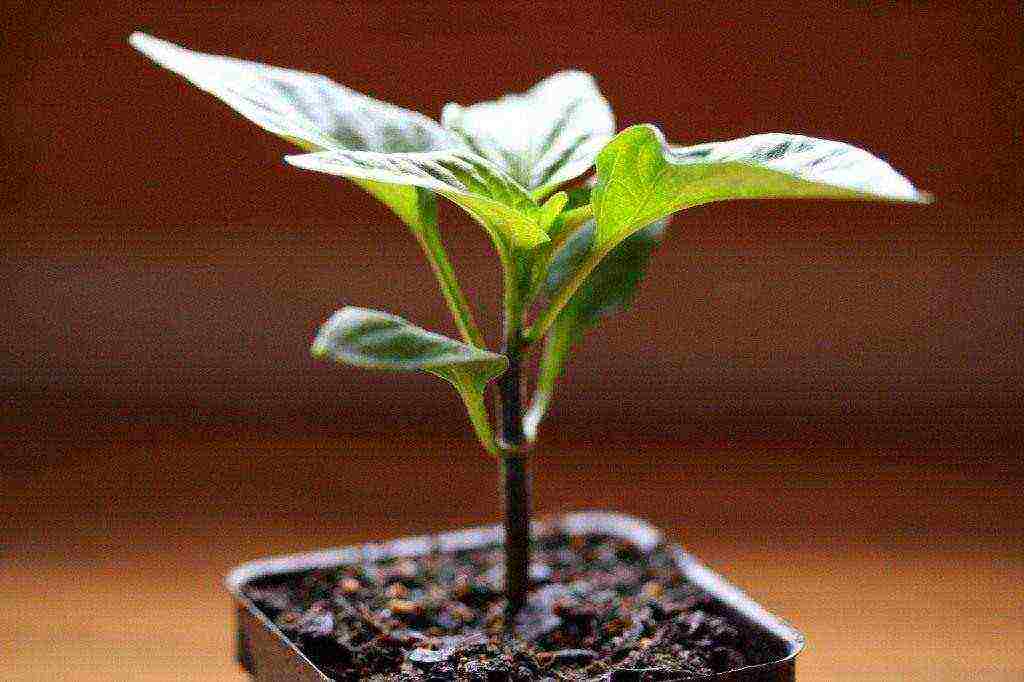
Variety selection
First you need to decide on the choice of pepper variety. You can pick it up individually for each consumer, because there are sweet, and spicy, and pungent varieties.At the same time, the cultivation of, for example, the same sweet bell pepper is no different from its other varieties. They are equally demanding on lighting, moisture and temperature.
There is a huge selection of peppers on the market today.
It's not hard to get lost in such a variety, so here's a quick reference:
- high-yield varieties: Big Papa, Bogatyr, Bugai;
- varieties for greenhouses: Ilya Muromets, Orange Miracle, Gambler;
- early varieties: "Tenderness", "Buratino", "Winnie the Pooh";
- late varieties: "Swallow", "Nochka", "Alyonushka";
- spicy varieties: "Adjika", "Astrakhansky".
Seed treatment
The first step is to visually inspect the seeds. Small, damaged and deformed ones must be removed. Then the seeds remaining as a result of selection are disinfected. They are placed in gauze bags, and then dipped in a dark pink concentrated solution of potassium permanganate for 20-30 minutes.
Also, you can dip them into a solution of any fungicide ("Fitosporin", "Vitaros"), following the instructions for use. After that, the seeds are thoroughly washed with running water.
To obtain strong and healthy seedlings, pepper seeds can be soaked in a complex nutrient solution. For example, you can add nitrophoska or wood ash to the water at the rate of 1 tsp. substances per 1 liter.
In such a mixture, gauze bags with seeds must be kept for 24 hours. You can also use the drug "Azotfit" (5-10 ml per 0.5 l of water). In this solution, pepper seeds are kept for 2 hours.
Another option is to dip the seeds in gauze for 24 hours in a liquid solution of the Ideal fertilizer. The temperature of the solution should be 25-28 degrees Celsius. Well, the last, but no less effective solution is to soak the seeds in Epin (this is a growth stimulant) for 12 hours. One or two drops of the drug are enough for every 100 ml of water.
Germination and hardening
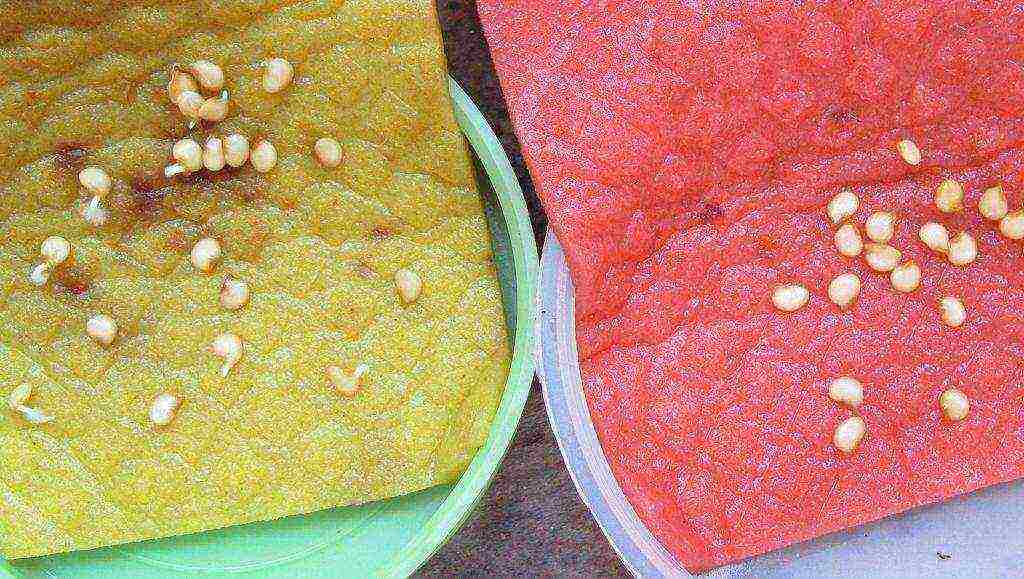
After the above procedures, the seeds of the peppers are germinated. This is best done on a raised surface (such as a saucer, plate, or jar lid). A moistened gauze, cotton wool or cotton cloth is placed on the bottom of the container.
Pepper seeds are evenly placed on top (they must be of the same grade) and covered with the same moist material. After that, the container is covered with a film and placed in a warm place (the air temperature must be at least 25 degrees Celsius). Periodically, water is poured into the fabric so that the seeds do not dry out. After 1-2 weeks, they will sprout. After that, they can be planted in seedling containers.
But before planting, bell peppers can be hardened using a simple, simple trick. The seeds of the peppers must be kept alternately in the cold, then in the warmth.
First, the planting material is placed in the refrigerator for 2 days (on the bottom shelf). Then they are kept indoors at room temperature (17-18 degrees) for 24 hours. Then they are again transferred to the refrigerator, and after two days, the seeds are taken out and immediately sown.
Choice of capacity

Sweet pepper has a very delicate root system; the culture takes a long time to recover from damage. Therefore, picks should be avoided by initially planting seeds in separate large containers (10x10 cm) or seedling boxes (at least 6 cm deep).
Pots or large glasses with a depth of 10-12 cm and a diameter of 7-10 cm are perfect. The container should be spacious (so that a large lump of earth can be transferred with the seedlings later) and deep (low containers negatively affect the growth of bell pepper).
Experienced gardeners do not recommend planting sweet pepper seeds in pressed cardboard pots, as the glue used in them can be toxic to seedlings.
Soil preparation
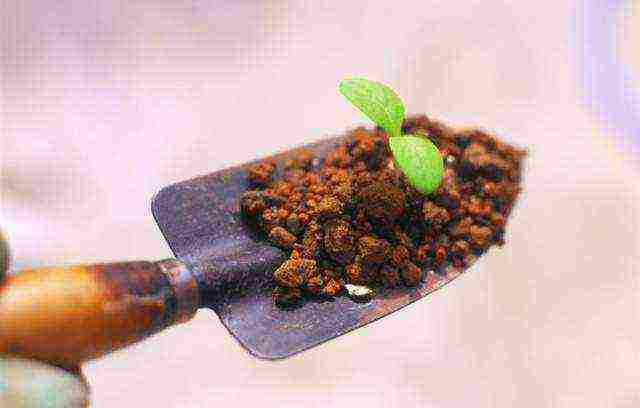
The successful cultivation of peppers from seed largely depends on the correct selection and preparation of the soil. Clayy and heavy soil with high acidity will not work. It is better to prepare the substrate yourself.
There are a number of requirements for the soil:
- fertility;
- looseness;
- moisture capacity;
- nutritional value;
- neutral or slightly acidic reaction (6-6.5 pH).
The soil should also be free of pathogenic bacteria and pests.
There are several options for preparing the substrate:
- Mix sandy loam meadow soil with peat and humus in a ratio of 2: 2: 1. For 10 kg of substrate, 2 matchboxes of superphosphate and 1 boxes of potassium sulfate are added to the mixture.
- Mix the top layer of soil, high-moor peat and sand in a 1: 2: 1 ratio. The acidity of the mixture can be extinguished by adding lime fertilizers to it.
- Mix humus, turf soil and river sand in a ratio of 3: 3: 1. A glass of wood ash is added to 10 kg of the mixture.
In addition, ready-made substrates (for example, "Biogrunt" and "Zhivaya Zemlya") are sold in specialized gardening stores. This is an excellent solution for summer residents who do not have access to the above components, and for beginners who are not yet confident in their abilities.
Sowing seeds
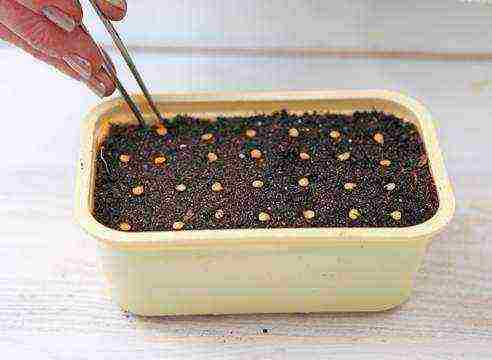
Sowing dates
When to sow sweet pepper seeds? It all depends directly on the variety. More specifically, from its ripening time. Early and mid-early varieties of peppers should be sown during March. In this case, the seedlings are transplanted into open ground after 50-60 days.
Mid-late and late varieties are sown from mid-February to mid-March. For planting seedlings in open ground, its age should be 60-75 days.
Planting is usually done at the end of April. First, the seedlings can be planted in a heated greenhouse (around the end of April), in the second half of May, they are moved to a greenhouse, and in the first half of June, the pepper is already planted in open ground.
Sowing process
Finally, we proceed to sowing seeds. To begin with, the containers for planting are washed. Then they are filled with earth, it is lightly tamped. The rim of the container should rise about 2 cm above the soil surface.
In the seedling box, parallel grooves are made with a depth of 1-1.5 cm, keeping a distance of 3-4 cm between them. Pepper seeds are planted at a distance of 1-1.5 cm from each other. In separate containers, two holes are made. One seed must be planted in each hole.
After that, they are covered with a substrate from above. At the end, each container is covered with a thin cling film and placed in a warm place (for example, near a battery).
Necessary conditions for seed germination
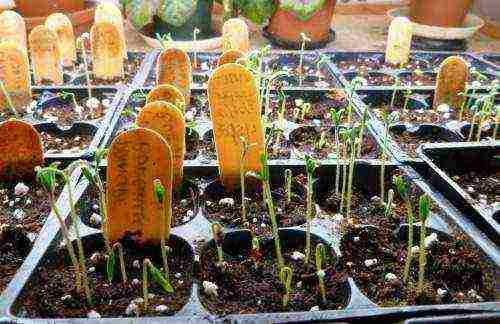
For fast germination of seeds, it is necessary to create a greenhouse effect. As already mentioned, the container with the planting must be covered with foil or glass and placed in a warm place. The air temperature should be 25-28 degrees Celsius. It must be maintained until the first shoots appear. If the appropriate regimen is observed, this happens 5-7 days after sowing the seeds.
Throughout this period, the soil should be moderately moist. Water must not collect in the sump. Watering is carried out with warm water through a sieve or watering can, so as not to expose the seeds and knock them out of the soil.
Another important aspect is lighting. Bell pepper is a light-loving and heat-loving culture. There is enough sunlight on the windowsill for her, but at the same time it is cool there. Therefore, it is better to use a phytolamp (it will come in handy after germination).
Growing seedlings

Temperature regime
So how to grow pepper seedlings from seeds at home? After the appearance of the first shoots, the containers with seeds are moved to a light window sill and the film is removed from them. The daytime temperature should be 13-16 degrees, and the nighttime temperature should be 8-10 degrees.
Such conditions should be observed during the week. During this period, the root system of the seedlings is formed, and this temperature regime contributes to its strengthening. A week later, the temperature is again raised to 25-27 degrees during the day and 17 degrees at night.
A month before planting in a permanent place, the seedlings begin to be taken out into fresh air in order to gradually harden it and allow it to get used to the environmental conditions.
Watering
Watering is also important.In the first few days after the emergence of seedlings, it is not necessary to moisten the soil. Sweet pepper seedlings are watered every 7 days. Water is poured under the root, trying not to fall on the sprouts. The temperature of the liquid should be 28-30 degrees.
You cannot water the seedlings of peppers with cold water. Periodically, the topsoil must be carefully loosened.
Lighting
Bell peppers are very fond of light. At home, it is advisable to place a container with seedlings on the lightest windowsill (preferably on the south side).
During the first two to three weeks, it is advisable to use additional lighting (the same phytolamp). The containers need to be unwrapped periodically so that the lighting is uniform throughout the growing period.
Picking
If the seeds were planted in seedling boxes or small pots, then after the development of two to four true leaves (about a month after germination), the seedlings of peppers should be dived into separate containers with a volume of at least 0.5 liters.
Top dressing
When the first shoots appear, top dressing is applied. It can be liquid yeast or ash fertilizers. Any complex preparation for seedlings (for example, "Kemira Combi") is also suitable.
After that, fertilizing is applied twice more:
- 2 weeks after the pick (5 g of urea and 30 g of superphosphate are dissolved in a bucket of water);
- a few days before planting seedlings (50 g of superphosphate and 25 g of potassium sulfate per bucket of water).
The flow rate is the same as for regular watering. You can also use ready-made fertilizers from the store ("Solution", "Agricola").
Planting seedlings in the ground
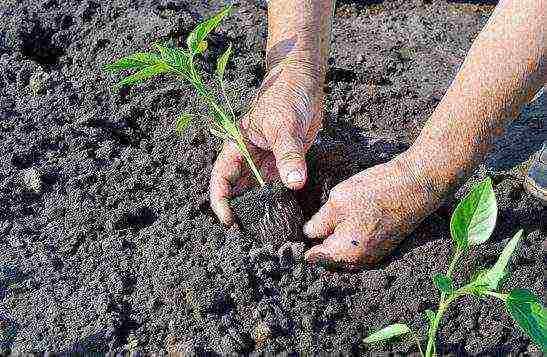
We figured out how to grow pepper seedlings from seeds at home. Now it is important that the fruits of our labors are not wasted. Sweet pepper seedlings still need to be properly planted. Planting is carried out after the appearance of the first buds. In this case, the plant should have at least six to eight leaves.
The soil should be well warmed up by the sun, so planting should be planned for late May or early June. Seedlings are carefully taken out of containers, before planting they need to be watered (so that a soil lump remains on the roots).
If the plant grew in peat pots, then it is not taken out from there, but planted along with the container. For hot peppers, the distance between the rows should be about half a meter, for sweet peppers - 70 cm.In one row, plants are placed every 40-50 cm.
Seedlings are planted in the evening, the air temperature should be at least 17 degrees. Bulgarian pepper is deepened into the soil until the first leaves. The hole is buried, the earth is slightly loosened. Young leaves of peppers are very fragile and tender, so it is recommended to tie them up after planting.
If the temperatures are low at night and there is a possibility of frost, then it is advisable to cover the seedlings with a thin film until stable warm weather is established.
Despite the laborious process of growing pepper seedlings from seeds, this crop remains one of the most popular and in demand. The main thing is desire and a responsible approach. And then growing this healthy vegetable will be an easy task for any gardener.
.
Such a useful and invaluable vegetable like pepper is planted in greenhouses, but under certain conditions it matures in the open field. This plant is quite challenging for beginners. Knowledge of the agricultural technology of this crop, as well as compliance with the rules for its cultivation, will allow you to get a good harvest. High-quality seedlings of peppers, which are obtained at home, are of great importance.

Seed peppers can be grown with the correct understanding of its agricultural technology.
Where to begin
Peppers do not tolerate cold weather and its sudden changes. For this culture, the temperature should not be lower than 18 degrees Celsius. Therefore, it is very often grown in greenhouses. If there is no greenhouse, seeds begin to be sown as early as February, so that they can be planted in open ground in May. If you plant pepper at the end of March, then the plants will begin to bloom only in August.
To get the harvest of this vegetable you need:
- choose the right variety of pepper;
- prepare the soil and plant seeds;
- grow seedlings at home;
- transplant seedlings into a greenhouse;
- maintain the conditions necessary for fruit ripening.
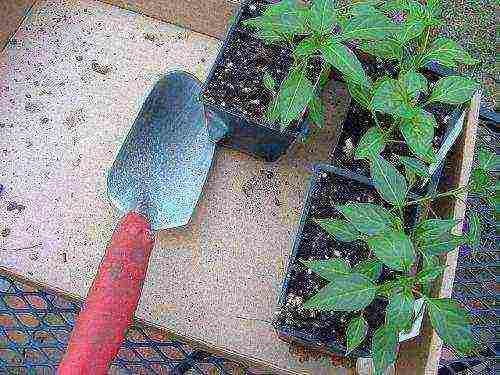
To plant seedlings in May, seeds must be planted in February.
Which variety to choose
Pepper can be hot, semi-hot and sweet. There are no particular differences between the cultivation of sweet bell peppers and other types of it. All these plants are demanding for light, warmth and proper watering.
There are many varieties of pepper on the market today. Gardeners choose the desired color and shape of the vegetable, and also take into account the purpose of its consumption. If you plan to use fresh pepper, sometimes one variety is enough.
Almost any variety can be grown in the greenhouse, provided that it can be heated. Big Papa, Bogatyr, Bugai, California Miracle will not disappoint with their harvest. For unheated greenhouses, "Ilya Muromets", "Gambler", "Orange Miracle", "Karapuz" are suitable. In the early stages, "Buratino", "Tenderness", "Winnie the Pooh" ripen, later "Alyonushka", "Swallow", "Night".
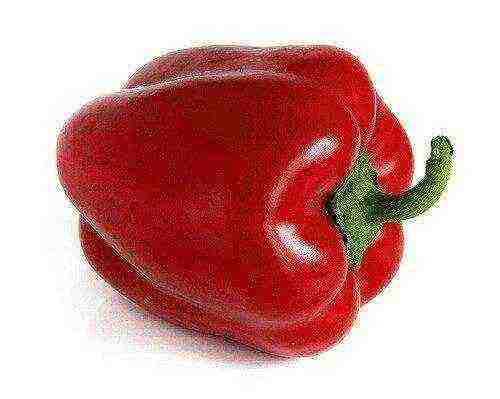
Pepper Ilya Muromets is suitable for greenhouses without heating
Soil and seed preparation
Fertile soil is one of the important criteria for growing quality seedlings. Some gardeners purchase ready-made potting mix. It should be loose, water-absorbing and lightweight. You can also compose it yourself. To do this, mix the earth with turf and sand, in a ratio of 2: 1: 1. One tablespoon of wood ash with superphosphate is added to ten liters of such soil.
It is advisable to disinfect the resulting mixture with a solution of potassium permanganate. Garden soil is not suitable for the preparation of the substrate. If the soil has been left from last year or taken from a summer cottage, it is necessary to warm it up in order to destroy possible pests. This is done on a baking sheet in the oven. You can boil the soil in a colander over a pot of water for an hour.
It is better for novice gardeners to purchase special soil in order to avoid failures. Substrate "Biogrunt" is quite widespread and popular, and "Zhivaya Zemlya" already contains all the necessary fertilizers.
The strength and health of future shoots depends on the seed, the preparation of which must be taken seriously. Before you start planting, you need to process the seeds. To increase germination, the following methods are used:
- First of all, the seed is examined and sorted out.
- Bell pepper seeds are kept in a weak solution of potassium permanganate for about 15 minutes, and then washed and dried. You can use solutions "Maxim", "Epin", "Fitosporin-M".
- To enrich them with useful microelements, an aqueous solution of potassium humate is used. You can place the seeds in a cloth and leave them in a mixture of two grams of wood ash and a liter of water for three hours.
- To see the sprouts faster, the seeds are placed in wet gauze and left in a warm place. When a young stem appears, sowing begins in the prepared soil.
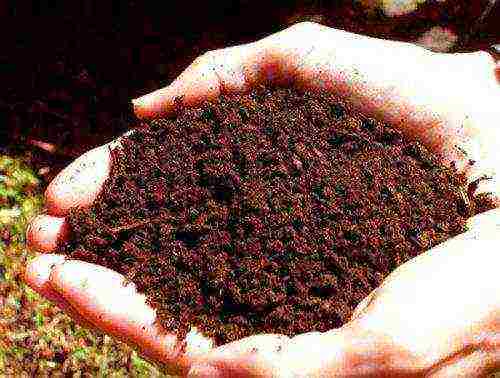
Biogrunt substrate is suitable for growing pepper seedlings
Sowing seeds
Usually, the fruits ripen in 100-150 days after the first leaves appear, and the seedlings are planted in 60-80 days. But it is necessary to take into account the characteristics of each variety in order to accurately calculate the time for sowing.
Prepare containers or pots for planting in advance by washing them in a solution of potassium permanganate or with laundry soap. It can be peat pots or plastic cassettes. The best option would be dishes that decompose in the ground. Then it will be possible to plant sprouts in open ground without removing the plants. Paper cups or peat pots will do.
The substrate is compacted in a container so that about two centimeters remain to its edge. Seeds are planted no deeper than ten millimeters.The distance between them will be about three centimeters.
When using cassettes, one grain is placed in each cell. Then they are pressed by hand, sprinkled with soil mixture and watered abundantly.
The containers are covered with glass or foil and left in a warm place. If several varieties have been used, it is advised to designate them with notes with the appropriate names.
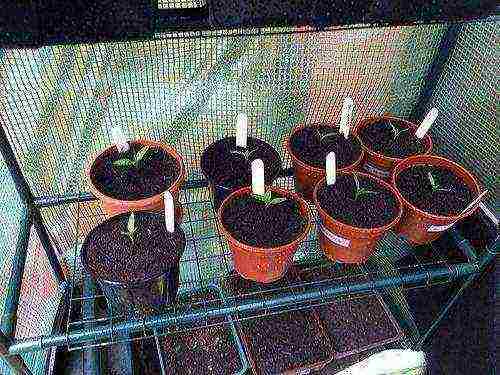
Pepper seedling pots should be labeled depending on the variety
Seedling care
During the first week, the root system of the plants is formed. The favorable temperature at this time is 14-16 degrees Celsius. Then it is raised to 25 degrees during the day and 17 at night.
After about a month, the first true leaves appear. During these days, it is necessary to water the seedlings once a week and feed them with special fertilizers. A solution of one tablespoon of calcium nitrate in a bucket of water will do. A popular store drug is Kemira Kombi.
Do not get carried away with watering. This can lead to the development of infection and death of the mouth. If the seedlings are rarely and unevenly moistened, they will shed their leaves and weaken. The water temperature should be about thirty degrees. Do not pour cold water on peppers.
To grow a quality crop, you need sunlight. At home, you need to make sure that the seedlings stand on the window where there is more light. It is desirable that this is the south side. Sometimes you will have to use additional lighting. If the sowing is late, the backlight duration is three or four weeks, the rest of the seeds have two or three. Illumination should be uniform throughout the growing period.
Sometimes small bugs appear on the seedlings - aphids. They feed on the sap of the leaves and harm the plants. Many pest control chemicals cannot be used at home. Then folk remedies will do. For example, five grams of crushed soap is dissolved in one liter of water. Plant leaves are washed with this composition. Decoctions of yarrow or garlic are also effective remedies that will help get rid of insects.
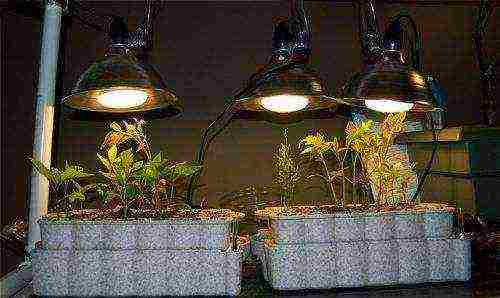
With a lack of sun, peppers, like other vegetables, need additional lighting.
Picking and hardening
Acceptance of picking allows you to grow strong seedlings that can provide a high yield. It represents the pinching of the terminal part of the main root. This is done for the growth of lateral and adventitious roots, stimulating the branching of the root system. When the seedlings have the first two leaves, you can start picking. If the seeds were planted in a common box, now they should be planted separately.
The pepper is dived as follows:
- Seedlings are carefully taken and placed in the hole so that the roots do not bend and are freely located in the ground. Plastic cups or cassettes with a diameter of 8-10 centimeters are used as containers. Their bottom should have small holes to avoid stagnant water.
- You can take the same soil as for sowing. The plant is placed in a hole, it is advised to deepen the root collar by 5 mm.
- The seedlings are then watered gently and a nutrient solution for irrigation is applied, which consists of one teaspoon of potassium sulfate and ten liters of water.
- The containers are placed in a place protected from direct sunlight. Fluctuations in temperature should not be outside the normal range. 13-15 degrees Celsius are considered acceptable.
- After two weeks, you need to feed the plants. You can use ready-made fertilizers: "Krepysh", "Agricola", "Solution". The second procedure is carried out after 14 days.
- After picking, it is advised to sprinkle with calcined sand around the stem. This promotes better moisture transfer to the root. Such a measure will protect the seedlings from the "black leg".
- Seedlings are watered once every 5 or 6 days using settled water at room temperature. Top dressing and watering are carried out in the morning.
Young plants must be hardened by the sun. They are accustomed to environmental conditions a month before planting in the ground. The pepper is taken out into the fresh air, gradually increasing the time spent in the open area. You can take it out to the balcony or just open a window. But drafts should not be allowed, which can adversely affect the growth and development of seedlings. If the air temperature is below 12 degrees, they are not taken out into the fresh air. Hardening will help the fruit grow two weeks earlier.
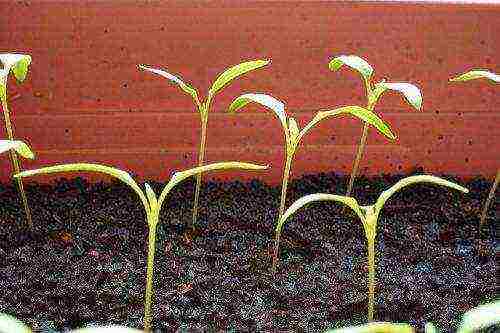
Seedlings with two leaves can already be dived
Landing
Seedlings are transplanted into the ground when the first buds have already formed and there are at least 8 leaves. The stem length usually reaches about 2.5 centimeters by this time. The time of planting plants in the ground cannot be missed.
Peppers are planted at the end of May and until mid-June, and in the greenhouse they do this already in early April. The soil should be warm enough, and the temperature should be 15-17 degrees Celsius.
Peppers take root better in the ground where cucumbers, pumpkins, carrots, cabbage or zucchini grew before. Before planting, it is necessary to water the seedlings with water to preserve the soil coma. The procedure is best done in the evening on a warm day. The plant is carefully removed from the container and placed in the hole until the first true leaves. They are very delicate and fragile, so they need to be tied to a support immediately after transplanting into the ground. Shallow loosening will help plants adapt faster to new conditions.
To protect peppers from low night temperatures and possible frost, additional plastic cover should be provided. They remove it after the desired temperature is established, from about mid-July.
For future seedlings, it is necessary to extract the grains from the fruit of the vegetable. The peppers are cut along the edge around the stalk. Then it is removed, and the seeds are shaken out and scraped out with a knife. They are dried under the sun, ground and cleaned of pulp and litter. In the case of acute and semi-acute varieties, protect the nose, eyes and mouth, and wear gloves. Seed material is stored for up to three years.
Despite some difficulties in growing seedlings, pepper remains one of the most popular and favorite vegetable crops. Experienced gardeners manage to get excellent fruits every year, be it hot, cold or rainy. The key to a rich harvest is a good mood and a desire to engage in this process. Then anyone can grow this bright and healthy vegetable.
Subscribe Be aware of new products on our site
